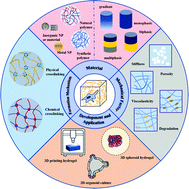Recent advances in 3D hydrogel culture systems for mesenchymal stem cell-based therapy and cell behavior regulation
Abstract
Mesenchymal stem cells (MSCs) have been increasingly recognized as a resource for disease treatment and regenerative medicine. Meanwhile, the unique chemical and physical properties of hydrogels provide innate advantages to achieve high quality MSCs on a large scale. Tremendous kinds of biomaterials have been employed to form hydrogels providing a controllable microenvironment for culturing MSCs. The development of materials science makes it possible to mimic the natural extracellular matrix (ECM), providing an effective means to understand mechanisms such as sensing and remodeling of the different microenvironments by MSCs. The mechanical cues, the formation mechanisms, material types and combination hydrogels are all discussed in this review for three-dimensional (3D) hydrogel culture systems. This article also focuses on the latest development of hydrogel culture systems applied both in vivo and in vitro. Besides the innovation of materials, the culture methods and spatiotemporal cues during the culture stage are other directions of exploration for 3D culture systems. The ultimate goal of hydrogel 3D culture systems is to perfectly mimic the native microenvironment for the study of MSC behavior or the applications of MSC-based therapies.



 Please wait while we load your content...
Please wait while we load your content...